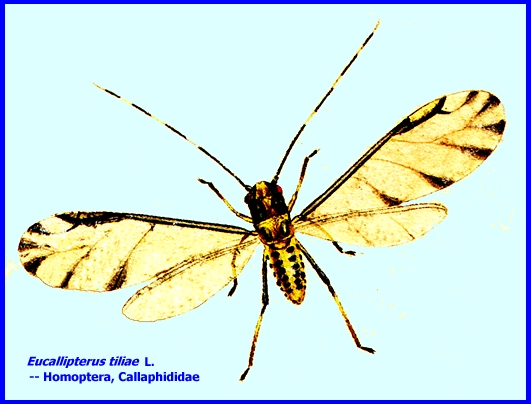FILE: <ch-108.htm> GENERAL INDEX [Navigate to MAIN MENU ]
|
TREE APHIDS Eucallipterus tiliae L. & Tinocallis platani (Kaltenbach) Homoptera -- Callaphididae & Aphididae (Contacts) ----- CLICK on Photo to enlarge &
search for Subject Matter with Ctrl/F. GO TO ALL: Bio-Control Cases Dahlsten & Hall
(1999) reported that both the linden aphid, Eucallipterus tiliae
L. and the elm aphid, Tinocallis
platani (Kaltenbach) were
examined for biological control in Berkeley, California. Tinocallis
platani is monophagous on
elm trees, and is naturally distributed from Europe and the Soviet
Union. It was introduced into western
North America (Richards 1967). Berkeley this aphid
reached high densities and its secreted honeydew created a nuisance by
dripping onto automobiles and people.
Insecticides were used exclusively in 1945-1971, but with decreasing
effectiveness (Olkowski et al. 1982b).
Two aphidiid parasitoids, Trioxys
hortorum Stary and T. tenuicaudus Stary were introduced from Czechoslovakia in
1972. Trioxys taenicaudus
became established and spread slowly.
Complaints of dripping honeydew decreased gradually also and now the
project is considered a classical biological control success (Olkowski et al.
1974, 1982b). Eucallipterus tiliae is
common in Europe on linden trees and was first found in the United States
>100 years ago in the area of Washington, D. C. It has occurred in the western United States for >50 years
having apparently spread from the east (Essig 1926). The aphidiid Trioxys curvicaudus
Mackauer was established in 1970 in Berkeley, marking the first use of a
parasitoid against an ornamental shade tree aphid pest (Olkowski et al.
1982a, Dahlsten & Hall 1999).
This parasitoid was also later established on T. platani
in central California (Dahlsten & Hall 1999). he
status of the biological control effort against linden aphid is not
considered clear by Dahlsten & Hall (1999), although Olkowski et al.
(1982a) consider it a success.
Populations of the linden aphid were low in 1971 with 40%
parasitization. In 1972 the aphid
populations were higher with parasitism ranging between 20-50% (Olkowski et
al. 1982a). Populations were not
sampled again until 1978 when parasitization did not exceed 30%. Approximately 50% of the aphid mummies
yielded hyperparasitoids (Olkowski et al. 1982a). Because the linden aphid populations were low in 1978 and
because there was less honeydew and fewer complaints, the project had been
considered successful (Olkowski et al. 1982a). Since 1981 this aphid and its parasitoids have been monitored
continuously. Data analyses for
1981-1982 showed no clear association between the numbers of aphids and its
parasitoids (Dahlsten et al. 1985).
Therefore, although complaints about honeydew have declined Dahlsten
& Hall (1999) hesitate to consider this a successful biological control
effort. Additionally T. curvicaudus was found to have several hosts and was not
specific to the linden aphid as previously believed. Also, Trioxys
pallidus, parasitoid of the
walnut aphid, parasitizes linden aphid (Dahlsten et al. 1985). REFERENCES: [Additional references may be
found at: MELVYL
Library ] Dahlsten, D. L. & R. W. Hall. 1999. Biological control of
insects in outdoor urban environments.
In: Bellows, T. S. & T. W. Fisher (eds.), Handbook of Biological Control: Principles and Applications. Academic Press, San Diego, New York. 1046 p. Dahlsten, D. L., A. E. Hajek, D. J. Clair,
S. H. Dreistadt, D. L. Rowney & V. R. Lewis. 1985. Pest management in the urban forest. Calif. Agric. 39(1-2): 21-22. Essig, E. O. 1926. The Insects of Western North America. MacMillan, New York. 1035 p. Olkowsky, W., D. Pinnock, D. Toney, W. Mosher, G., W. Neasbitt,
R. van den Bosch & H. Olkowsky.
1974. A model integrated
control program for street trees.
Calif. Agric. 28(1): 3-4. Olkowski, W., H. Olkowski & R. van den Bosch. 1982a.
Linden aphid parasite establishment.
Environ. Ent. 11: 1023-25. Olkowski, W., H. Olkowski, R. van den Bosch, R. Hom, R. Zuparko
& W. Klitz. 1982b. The parasitoid Trioxys tenuicaudus
Stary (Hymenoptera: Aphidiidae) established on the elm aphid Tinocallis platani Kaltenbach (Homoptera: Aphididae) in Berkeley,
California. Pan-Pacific Ent. 58: 59-63. Richards, W. R.
1967. A review of the Tinocallis of the world
(Homoptera: Aphididae). Canad. Ent.
99: 536-53. |

.jpg)